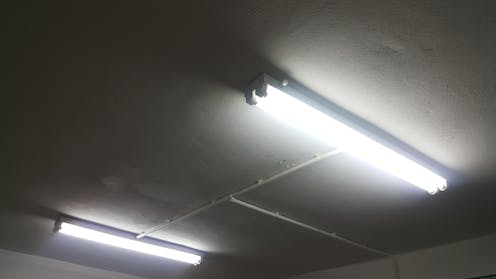I've always wondered: do fluorescent lights emit UV, and can it harm me?
- Written by Noushin Nasiri, Postdoctoral Research Fellow, School of Mathematical and Physical Sciences, University of Technology Sydney

This is an article from I’ve Always Wondered, a series where readers send in questions they’d like an expert to answer. Send your question to alwayswondered@theconversation.edu.au
I’ve always wondered, should I be concerned about experiencing UV damage from fluorescent lights? Am I at risk of skin cancer or premature ageing if I work in an office building lit with fluorescent lights? – Damien, Canberra, 26
Ultraviolet radiation is the highest-energy component of the Sun’s rays that reach the Earth’s surface. UV light stimulates the synthesis of vitamin D, which is an essential compound for growth of bones and teeth, as well as improved resistance against certain diseases.
On the other hand, too much UV radiation is the main cause of melanoma, which is a malignant form of skin cancer. This is why you’ve always been advised to protect your skin with sunscreen.
But what about the lights indoors? Do fluorescent lights also emit UV?
Read more: I've always wondered: what's behind the belly button?
The best way to find the answer is to firstly understand how fluorescent lights work. Inside the bulb, electrical discharge excites a gas (usually neon or mercury vapour in argon), which emits ultraviolet radiation. But the ultraviolet radiation is not visible to human eyes and must be converted into visible light. This is done by the light’s interior fluorescent coating, which is able to absorb most of the UV radiation and emit lower-energy wavelengths in the visible spectrum.
But some UV rays get through the bulb, especially if the bulb’s internal coating is cracked, allowing more UV light to pass through. In fact many types of lighting used in our homes emit small amounts of UV radiation.
But according to the Australian Radiation Protection and Nuclear Safety Agency (ARPANSA), the UV emissions from most indoor light sources, including fluorescent lights, are below the approved Australian limits. This means they won’t cause any risk to health for normal people, if we use them properly.
Safe distances
The emissions from all sources of light decrease rapidly with distance. At a typical use distance (more than 25cm), the UV light emitted from fluorescent lights falls below the level of general concern for healthy individuals.
Read more: I’ve always wondered: why do our computing devices seem to slow down?
The only exception is a medical condition that makes you particularly sensitive to UV light. The vast majority of people do not suffer from such UV or visible light sensitivities.
Exposure time
The longer the exposure time, the higher the UV dosage absorbed by the skin. At a measurement distance of 10cm, an exposure time of less than eight hours would be safe for almost all types of lights.
Compare this to the permissible exposure limits (PELs) in typical midday summer sunshine, which is six minutes in Brisbane and seven minutes in Sydney and Melbourne.
The UV level absorbed by our skin after eight hours’ exposure to indoor lights, at a typical use distance (25cm), would be equivalent to just over a minute of midday solar exposure on a clear summer day in a city such as Sydney or Melbourne. This shows the risk to us is very small indeed.
Read more: I've always wondered: why do our veins look blue when our blood is red?
Does the fluorescent tube have a cover?
If you have to spend a lot of time under fluorescent light, make sure fluorescent bulbs have plastic diffusers over them. The glass and the coating inside the glass used in fluorescent lights already provide a UV filter, which further reduces the already low levels of UV.
So, if a standard fluorescent tube lighting source is shielded by a standard acrylic plastic diffuser, there’s rarely a risk for human health, even for people who are affected by light sensitivity.
* Email your question to alwayswondered@theconversation.edu.au * Tell us on Twitter by tagging @ConversationEDU with the hashtag #alwayswondered, or * Tell us on Facebook
Authors: Noushin Nasiri, Postdoctoral Research Fellow, School of Mathematical and Physical Sciences, University of Technology Sydney



